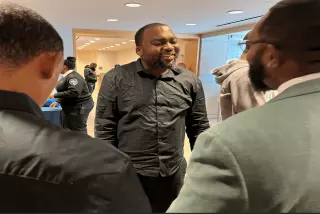Victim of Nail-Gun Accident Survives a Delicate Surgery
- Share via
When the medical helicopter arrived at Providence Holy Cross Medical Center last month, the patient inside was barely breathing, and doctors held little hope for him.
Construction worker Isidro Mejia had six nails in his head, including three embedded in his brain, one in his spinal column and one in his face.
While working at an Antelope Valley job site, Mejia, 39, stumbled on scaffolding and fell onto a co-worker who was using a nail gun, witnesses told authorities.
At the Mission Hills hospital, Dr. Rafael Quinonez looked at his comatose patient and puzzled over how to save him -- with an operation that wasn’t found in any medical books.
“The books, they cover bullets and maybe metal from car wrecks, but never nails in the head,” the neurosurgeon said.
Over several days of operations, Quinonez and his team meticulously pulled out the nails. With X-rays as maps and a camera scope as his guide, the neurosurgeon found the head of each nail inside Mejia’s skull and gingerly removed them.
On Wednesday, two weeks after his accident, Mejia said he felt lucky to be alive. Still hospitalized, the construction worker spoke slowly in Spanish. He had lost most of his English-speaking skills, doctors said, when one of the nails entered the frontal lobe of his brain, damaging the speech center.
“I thought I was going to die,” said the Lancaster man. His wife, Juana, stood beside him, touching his shoulder. “Now, I just hope to continue my life with my family,” including his four children.
He said he felt weak and the right side of his face remained numb, but his doctors predicted a full, if gradual, recovery.
As he sat in a wheelchair, too weak from surgery to stand, Mejia pointed to the scars on the side and back of his head and talked about his ordeal.
Mejia recalled that on April 19 he was walking on the wooden frame of a house his crew was building when he stumbled and fell. He said he heard the shots of the nail gun but did not remember much afterward.
Witnesses told Los Angeles County sheriff’s deputies they saw Mejia fall from the roof onto a co-worker who was using the nail gun on the second floor.
“The guy holding the nail gun was grabbing to keep from falling, and just gripped tighter on the trigger,” Deputy Mark Newlands said.
“It’s a nail gun they use for framing. It can drive nails through 2-by-4s, so you’re talking about a pretty powerful instrument,” Newlands said.
“Nail guns are strong enough to go through bone,” said Raul Samiego, a hardware salesman at a Los Angeles Home Depot store. “Most nail guns are pressure-sensitive. If you keep the trigger down, it will shoot rapidly without stopping.”
As paramedics rushed Mejia into the emergency room, he stopped breathing. The paramedics resuscitated him, but Mejia remained comatose.
In the trauma center, Quinonez took one look at his patient and thought the man’s chances were slim. But with no other option, Quinonez and his staff prepared for surgery.
Quinonez had performed a similar operation two years ago. In that case, he removed a nail that had entered the right nostril of a construction worker and burrowed past his eye socket into his brain.
But Mejia’s case was much more severe.
One nail had punctured the skull and was in the midline of the brain -- an area containing major blood vessels. If any vessels had ruptured, Mejia would have died, Quinonez said. Another nail had passed 2 millimeters from the brainstem, which controls movement and breathing. If the brainstem had been damaged, he would not have survived.
A third nail had entered the spinal column, but not the spinal cord. Three millimeters to the left and Mejia would have been a quadriplegic, unable to breathe or move.
Technicians did a barrage of X-rays and CT scans to pinpoint the location and trajectory of each nail.
Then, after nurses wheeled Mejia into the operating room, Quinonez proceeded with great caution. He opened the skin of Mejia’s head and, with a thin metal clamp, followed the tracks that the nail had made entering the skull. Probing by feel, he stopped when he detected metal touching metal.
Then, he opened the clamp around the round and flat surface of the nail’s head and began to pull ... slowly. A wrong move of millimeters in any direction could mean permanent brain damage.
But one by one, Quinonez extracted the 3 1/2-inch nails.
On April 23, four days after the nails punctured his patient’s skull, Quinonez pulled out the last nail.
Over the next week the swelling subsided in Mejia’s brain and he began breathing on his own. After a few more days, he began to talk. Some of his first words were thanks for the doctor who saved him.
On Wednesday, with his neurosurgeon standing beside him, Mejia said, “I feel so lucky.... I know I am lucky because I am alive.”
More to Read
Sign up for Essential California
The most important California stories and recommendations in your inbox every morning.
You may occasionally receive promotional content from the Los Angeles Times.













